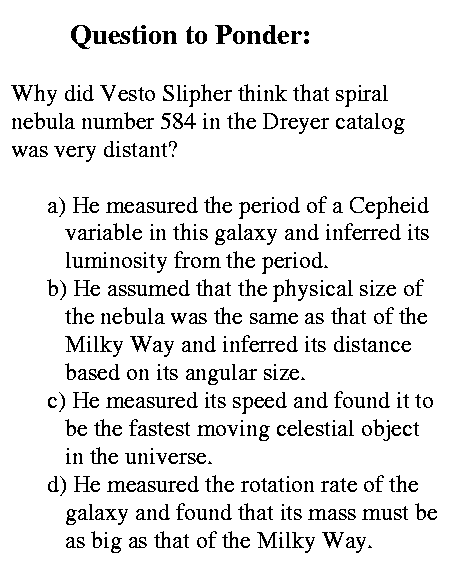|
|
The Universe itself keeps on expanding and expanding, In all of the directions it can whizz. As fast as it can go, at the speed of light you know, 12 million miles a minute and that's the fastest speed there is. So remember when you're feeling very small and insecure How amazingly unlikely is your birth, And pray that there's intelligent life somewhere up in space, Because there's bugger all down here on Earth. Monty Python, Galaxy Song |
Assignments:Read Chapter 35, Sections 1-2 (pp. 582-587)Problem Set #7 due Tuesday 20 April, 5:00 pm
|

In Class:
----------------
We left Hubble trying to determine the distances to really faraway gax
- ones for which he couldn't identify Cepheids
He used Herschel's method of assuming that all gax have the same luminosity
- measure flux --> calculate distance
like Herschel, he has some limited success
- reasons are actually the same:
- distances between objects are really huge
- for Herschel, star distances are large and
stars are "spread out" in the gax
- for Hubble gax distances are huge and
gax are "spread out" in the universe
- therefore, distance-dimming plays a pretty diminant role
in determining the flux we observe
- still, he doesn't get the right answers because gax DO NOT all
have the same luminosity
------------------------
Other ways to do the same thing:
i.e., find something whose luminosity you think you know, and
measure its flux
--> then used measured flux and assumed luminosity to infer distance
via flux = luminosity/(4 pi distance^2)
more modern and more sophisticated versions of this same process:
- type Ia SN
---------IF TIME----------
Type Ia: binary system w/ one RG star and one WD
- WD has already gone through its evolution
- should be a cooling hulk
- in the binary system, though, some of the RG material
gets pulled onto the WD
-- once enough gets onto the WD,
-- pressure from overlying material is so great as to
overwhelm electron degeneracy
-- WD collapses into Neutron star
in the same kind of SN explosion that occurs inside
a massive star
--------------------------
- blazingly luminous
- way more luminous than Cepheids
- easy to see and identify
- thought to be equally luminous at peak
- compare flux and assumed L -> get D
- globular clusters
- look at distribution in brightness
- should peak at a certain L (<-- according to models)
- compare flux and assumed L -> get D
--> IN general, find something intrinsically luminous
whose luminosity you think you know
- look for it in a gax
- compare flux and assumed L -> get D
- different techniques
- Tully-Fisher relation
- measure the rotation speed of spiral gax
- doppler effect
- compare speed on one side w/
speed on the other side
---> get mass estimate
- assume mass and luminosity are related
somewhat bogus assumption (or at least dangerous)
- get luminosity from rotation rate
- compare flux and assumed L -> get D
- remarkably it works!
- SN expansion rates
- when SN explodes, stuff is sent out in all directions
- take spectra to measure velocity toward us
- must be same speed sideways
- rate x time = distance
- measure angular size, have linear size
- Observer's Triangle
--> get D
--------------------------------------
So Hubble takes his distance estimates and compares with velocity measurements
Hubble's Hubble Law
1929: As you have seen (or will see) in lab, a pretty ratty relationship
1931: cleaned up considerably; extended to 30 Mpc
TODAY: Cepheid distances out to 20 Mpc (w/Hubble)
secondary distance indicators out to nearly 200 Mpc
Using the Hubble Law to map the universe
once you believe in the Hubble Law, you can turn it around
now measure velocity and infer distance
speed = (Hubble constant) x distance
somewhat dangerous practice
- really need to belive that the universe is expanding
and that the expansion is such that a Hubble Law
would hold
- you will test (or already have tested)
this issue in lab
- ALSO, need to know H very well
- that's pretty tough
|
![]()